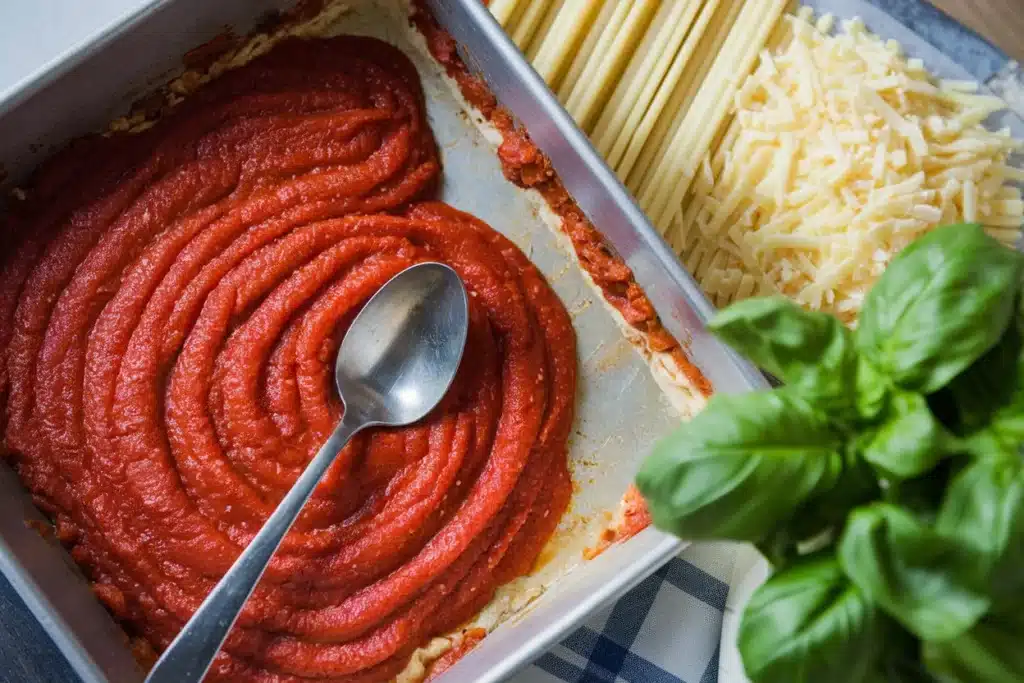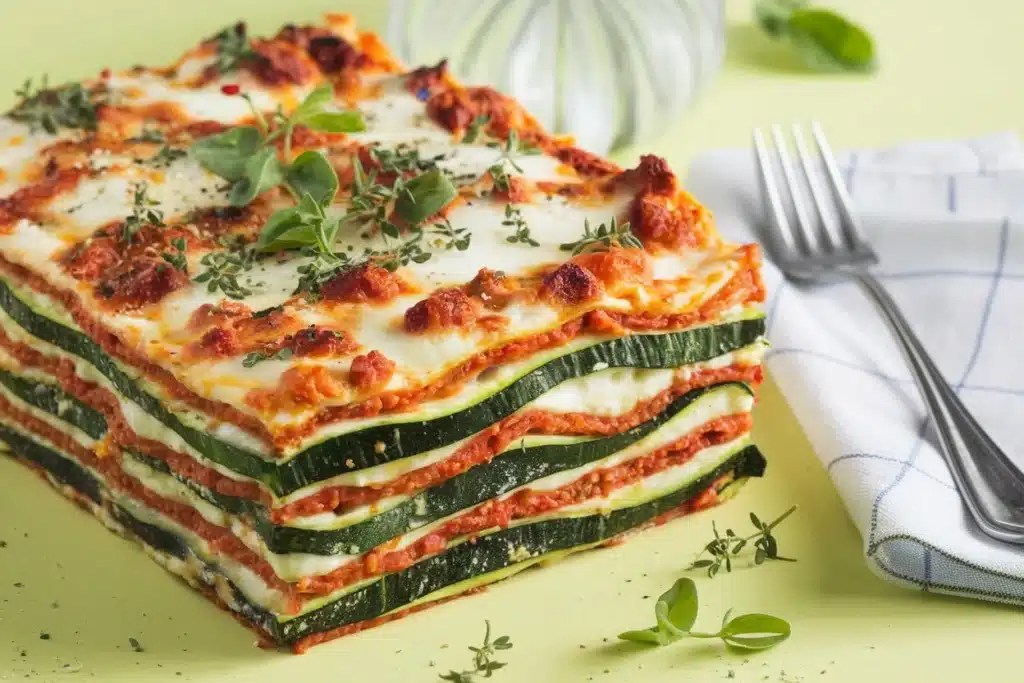Let’s face it: everyone loves a hearty, gooey, and perfectly layered lasagna. But have you ever wondered why some lasagnas turn out amazing while others feel like a mushy mess? The secret lies in how you layer it. Don’t worry; we’re going to unravel the mystery behind the best order to layer lasagna and make you a layering pro!
Art of Making Perfect Lasagna
Lasagna is more than just a casserole—it’s a masterpiece. Think of it like building a skyscraper. If the foundation and layers aren’t solid, the whole thing can collapse into chaos. Whether you’re a lasagna newbie or someone looking to refine your technique, this guide will help you stack each layer like a pro.
The Importance of Layering in Lasagna
Certainly! Here’s the revised version with maximum use of transition words:
“Layering isn’t just about stacking ingredients; instead, it’s about creating a symphony of flavors and textures. However, if you skimp on layering or, on the other hand, get the order wrong, you could easily end up with dry patches or, worse, a soggy mess. After all, nobody wants that, right?”
Why Does Layering Affect Flavor and Texture?
Here’s the thing: every bite of lasagna should, ideally, give you a little bit of everything—cheesy goodness, savory sauce, tender noodles, and hearty fillings. Therefore, proper layering ensures this. For instance, imagine biting into a lasagna with all the sauce pooled at the bottom or, alternatively, cheese clumped in one corner. Naturally, that sounds disappointing, doesn’t it?
Understanding the Components of Lasagna
Before diving into the layering technique, let’s break down the main components of lasagna. Knowing what each ingredient does will help you stack them like a pro.
The Role of Noodles: Fresh vs. Dry
Noodles are the backbone of your lasagna. Fresh noodles cook faster and are softer, while dry noodles hold up better during baking. Either works, but make sure they’re cooked just right—overcooked noodles will fall apart, while undercooked ones might stay crunchy. Pro tip: boil your noodles until they’re al dente, so they hold their structure.
Choosing the Right Sauce: Marinara, Béchamel, or Both?
Should you go classic with marinara or fancy with béchamel? Or both? Marinara adds that tangy tomato flavor, while béchamel gives a creamy, velvety touch. Combining the two? That’s lasagna nirvana! Just don’t go too heavy on the sauce, or you’ll end up with soggy noodles.
Essential Cheeses: Ricotta, Mozzarella, and Parmesan
The holy trinity of lasagna cheese—ricotta for creaminess, mozzarella for stretchiness, and Parmesan for that nutty kick. Layering these correctly ensures you get the perfect cheesy pull in every slice.
| Type | Calories | Protein | Fat |
|---|---|---|---|
| Ricotta | 428 | 14g | 32g |
| Mozzarella | 280 | 25g | 17g |
| Parmesan | 431 | 38g | 29g |
Adding Proteins: Meat, Plant-Based, or None
From ground beef and Italian sausage to plant-based crumbles, proteins bring heartiness to your lasagna. Layer them thinly to avoid overpowering the dish. If you’re skipping meat, no worries—lasagna is just as delicious without it.
Optional Vegetables: Enhancing Layers with Freshness
Adding veggies like spinach, zucchini, or mushrooms can elevate your lasagna. They bring freshness and balance out the richness of the cheese and sauce. Just make sure to sauté or roast them first, so they don’t release water and make your lasagna watery.
Step-by-Step Guide to Best Order to Layer Lasagna

Now that we’ve covered the essentials, let’s get to the fun part—layering! Think of this as painting a picture, with each layer adding its own color and texture.
Preparing Your Baking Dish: Greasing and Setup
First things first: you should grease your baking dish. Specifically, a light coat of olive oil or, alternatively, non-stick spray will not only keep your lasagna from sticking but also make cleanup a breeze. Additionally, it adds a subtle touch of flavor, which, of course, is always a bonus.
First Layer: The Base Sauce
Start with a thin layer of sauce at the bottom. This prevents the noodles from sticking and creates a moist base for the dish. Think of it as the canvas for your lasagna masterpiece.
Second Layer: Noodles—Positioning and Spacing
Lay your noodles flat over the sauce, slightly overlapping each other. If they don’t fit perfectly, trim them to size. Pro tip: don’t stack raw noodles directly; always separate layers with sauce or filling.
Third Layer: Ricotta Mixture
Spread a layer of ricotta mixed with egg, Parmesan, and seasoning. This creamy layer is what makes lasagna feel luxurious.
Fourth Layer: Protein or Vegetables
Sprinkle your chosen protein or veggies evenly. Keep the layer thin to avoid overwhelming the dish. A little goes a long way!
Want to know more about repeating layers, top crust tips, and avoiding common mistakes? Stay tuned for the next part!
Repeating Layers: Tips for Maintaining Balance
Once you’ve completed the first set of layers, it’s time to repeat the process. Think of it as building a lasagna tower! Stick to the same order—sauce, noodles, ricotta mixture, protein or veggies, and cheese. However, remember not to overload any single layer. Balance is key to making sure each bite is consistent and delicious. Too much filling in one spot could lead to a lasagna landslide.
Top Layer: Sauce and Cheese for a Perfect Crust
The final layer is where the magic happens. Cover the top noodles with a generous amount of sauce to keep them moist during baking. Then, sprinkle a thick layer of shredded mozzarella and Parmesan. This forms a golden, bubbly crust that’s practically irresistible. Want an extra crunch? Add a touch of breadcrumbs or herbs on top for a gourmet finish.
Common Mistakes in Layering Lasagna and How to Avoid Them
Even the best chefs make mistakes, but the good news is you can avoid them! Let’s tackle some common lasagna blunders and how to fix them.
Overloading Ingredients: Why Less is More
It’s tempting to go heavy on cheese or sauce, but too much can ruin the dish. Overloading leads to uneven cooking, soggy layers, or a collapsed lasagna. Aim for thin, even layers that complement each other. Remember, lasagna isn’t about one ingredient—it’s about the harmony of all its components.
Uneven Layers: Balancing Thickness Across the Dish
Ever cut into a lasagna and find one side taller than the other? Uneven layers are often caused by rushing through the process. Take your time, spread each layer evenly, and make sure the dish is level before baking. You’re not just making food; you’re creating edible architecture!
Skipping the Sauce Base: Preventing Sticking
One of the biggest mistakes is forgetting the base sauce layer. Without it, your noodles will stick to the dish and dry out. Always start with a thin layer of sauce before adding noodles—it’s like putting a non-stick shield at the bottom.
Solutions to Common Problems When Layering Lasagna
Problems happen, but every lasagna mishap has a fix. Let’s dive into some common issues and how to handle them.
How to Prevent Soggy Lasagna Layers
Soggy lasagna is often caused by excess water in the ingredients. Here’s the fix:
- Drain and pat dry any cooked vegetables before layering.
- If using ricotta, mix it with an egg to reduce water content.
- Let the lasagna rest for 10–15 minutes after baking to allow excess moisture to absorb.
Follow these tips, and your lasagna will hold its shape beautifully.
Fixing Cracked or Undercooked Noodles
Cracked noodles? That’s usually from overcooking or improper layering. Make sure you cook noodles until al dente and cover them fully with sauce when layering. For undercooked noodles, add a splash of water to the sauce before baking to give them more moisture to cook.
Salvaging an Overcooked Top Layer
If the top layer gets too dark or crispy, cover the dish with aluminum foil while baking. Remove the foil in the last 10 minutes to allow the cheese to bubble and brown slightly.
Tips for Achieving the Best Order to Layer Lasagna
Now that we’ve solved the common pitfalls, here are some pro tips to make your lasagna unforgettable.
Resting Time: Why You Should Let Lasagna Set
This step is a game-changer! Once your lasagna comes out of the oven, let it rest for at least 10–15 minutes. This allows the layers to firm up, making it easier to slice and serve. Trust me, patience pays off here.
Cutting and Serving: Ensuring Neat Slices
When it’s time to serve, use a sharp knife to cut through the layers cleanly. A spatula works best for lifting out perfect squares. Pro tip: wipe the knife clean between cuts to keep your slices looking neat.
Using the Right Tools: Spatulas and Knives for Perfect Layers
Having the right tools, without a doubt, makes all the difference. For example, a flat spatula for serving and, additionally, a serrated knife for cutting are absolute must-haves. Moreover, these little details can effortlessly turn you from an ordinary home cook into a true lasagna pro!
Alternative Layering Ideas for Unique Lasagna Recipes

If you’re ready to shake things up, let’s explore some fun and creative ways to layer your lasagna. Whether you’re catering to dietary needs or just looking for a twist, these ideas will keep things exciting!
Vegetarian Lasagna: Layers Packed with Veggies
Who says lasagna needs meat to be hearty? A vegetarian version can be just as satisfying, if not more. Instead of meat, try roasted zucchini, eggplant, spinach, or even butternut squash. Layer these with marinara and ricotta for a burst of flavor and freshness. The key is to cook your veggies beforehand to remove excess moisture.
Gluten-Free and Keto-Friendly Layering Tips
For those avoiding gluten, replace traditional noodles with alternatives like:
- Thinly sliced zucchini or eggplant
- Sheets of cooked sweet potato
- Store-bought gluten-free lasagna noodles
Keto lovers can go noodle-free altogether, relying on layers of cheese, sauce, and low-carb vegetables.
Creative Twists: Pesto, Alfredo, and Beyond
Feeling adventurous? If so, you could swap out traditional marinara with a layer of pesto for a fresh, herby twist. Alternatively, you might use Alfredo sauce for a creamy, decadent version. Furthermore, you can even mix and match sauces within the same lasagna, thereby creating a burst of different flavors in every single bite.
FAQs: What Is the Best Order to Layer Lasagna?
1. What is the Best Order to Layer Lasagna?
The classic order is:
- Sauce (as the base layer)
- Noodles
- Ricotta mixture
- Protein or vegetables
- Repeat until the top layer, finishing with sauce and cheese.
2. How many layers should a lasagna have?
A good lasagna typically has 3 to 5 layers. However, the number of layers depends on the depth of your baking dish. Always end with a layer of sauce and cheese on top.
3. Should I cook lasagna noodles before layering?
Yes, if you’re using traditional dry noodles, cook them until al dente. Some recipes call for no-boil noodles, which can go straight into the dish if you use enough sauce to ensure they cook properly.
4. How do I keep my lasagna from being soggy?
- Drain and pat dry any vegetables before layering.
- Mix ricotta with an egg to reduce moisture.
- Avoid overloading with sauce.
- Let the lasagna rest after baking to absorb any excess liquid.
Explore More Delicious Recipes
If you’re craving more ideas to perfect your table, check out these delightful recipes on Rita Flavors:
- Layering Lasagna Like a Pro
- Smart Tips to Elevate Your Lasagna’s Flavor
- Classic Barilla Lasagna Like an Italian Chef
Conclusion: Mastering the Best Order to Layer Lasagna
And there you have it—the ultimate guide to layering lasagna like a pro. By understanding the components, avoiding common mistakes, and experimenting with new ideas, you can create a lasagna that’s not just good but legendary.
So, next time you’re in the kitchen, remember these tips and get ready to impress your friends and family. And don’t forget to let your lasagna rest—it deserves a little nap after all that effort!
Lasagna Nutrition Facts (Traditional Recipe per Serving)
| Nutrient | Amount |
|---|---|
| Calories | 350 |
| Protein | 20g |
| Fat | 15g |
| Carbohydrates | 30g |
| Fiber | 3g |
| Sodium | 800mg |
Ready to create your Best Order to Layer Lasagna masterpiece? Share your creations with us! Snap a photo, tag it with #LasagnaLayeringGoals, and let’s celebrate your delicious success!
Happy cooking with Rita chef ❤️!
Print
Layering Lasagna for the Best Texture & Taste
- Total Time: 1 hour
- Yield: Serves 6 to 8 1x
Description
Discover the secrets to perfectly layered lasagna that’s rich in flavor, gooey with cheese, and holds its structure beautifully. This guide will show you how to layer lasagna step-by-step for the best texture and taste. Whether you prefer a classic meat lasagna or a veggie-packed version, mastering the art of layering will elevate your dish to new heights.
Ingredients
For Classic Lasagna:
12 lasagna noodles cooked al dente
2 cups marinara sauce
1 cup béchamel sauce optional for added creaminess
1 pound ground beef or Italian sausage cooked and drained
2 cups ricotta cheese
1 large egg for the ricotta mixture
2 cups shredded mozzarella cheese
1 cup grated Parmesan cheese
1 tablespoon olive oil for greasing the baking dish
Salt and black pepper to taste
Fresh basil or parsley for garnish
Optional Vegetables:
1 cup spinach sautéed and drained
1 zucchini sliced and roasted
1 cup mushrooms sautéed
Instructions
Lightly grease the baking dish with olive oil to prevent sticking and ensure easy cleanup
Spread a thin layer of marinara sauce on the bottom of the dish to prevent the noodles from sticking and to add moisture
Lay lasagna noodles flat over the sauce slightly overlapping the edges Trim if needed to fit the dish
Mix ricotta cheese with the egg salt pepper and a bit of Parmesan Spread an even layer over the noodles
Add a thin layer of cooked ground meat or sautéed vegetables Distribute evenly to ensure balanced flavor
Sprinkle a generous layer of mozzarella and a light dusting of Parmesan for that perfect cheesy pull
Continue layering in the same order sauce noodles ricotta mixture protein or vegetables and cheese until you reach the top
Finish with a final layer of noodles topped with sauce and a generous sprinkle of mozzarella and Parmesan for a golden bubbly crust
Cover the dish with foil and bake at 375°F 190°C for 25 minutes Remove the foil and bake for an additional 15 minutes until the cheese is golden and bubbly
Let the lasagna rest for 10 to 15 minutes before slicing to help the layers set and make serving easier
Notes
Mix ricotta with an egg to reduce moisture and create a creamy texture
Drain sautéed vegetables thoroughly to prevent a watery lasagna
Allow the lasagna to rest after baking for clean, neat slices
For extra flavor sprinkle Italian seasoning or fresh basil between layers
- Prep Time: 20 minutes
- Cook Time: 40 minutes
- Category: Main Dish
- Method: Baking
- Cuisine: Italian
Nutrition
- Serving Size: 1 slice
- Calories: 350 kcal
- Sugar: 6 g
- Sodium: 800 mg
- Fat: 15 g
- Saturated Fat: 7 g
- Unsaturated Fat: 6 g
- Trans Fat: 0 g
- Carbohydrates: 30 g
- Fiber: 3 g
- Protein: 20 g
- Cholesterol: 60 mg

